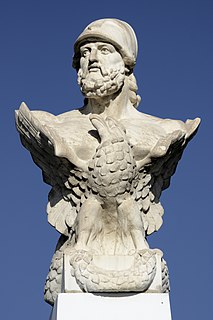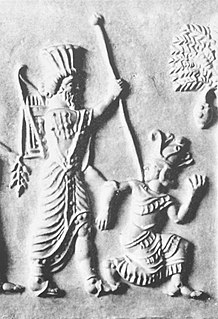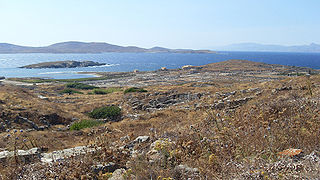
The Delian League, founded in 478 BC, was an association of Greek city-states, with the number of members numbering between 150 and 330 under the leadership of Athens, whose purpose was to continue fighting the Persian Empire after the Greek victory in the Battle of Plataea at the end of the Second Persian invasion of Greece.

The 5th century BC started the first day of 500 BC and ended the last day of 401 BC.

Xerxes I, commonly known as Xerxes the Great, was the fourth King of Kings of the Achaemenid Empire, ruling from 486 to 465 BC. He was the son and successor of Darius the Great and his mother was Atossa, a daughter of Cyrus the Great, the founder of the Achaemenid empire. Like his father, he ruled the empire at its territorial apex. He ruled from 486 BC until his assassination in 465 BC at the hands of Artabanus, the commander of the royal bodyguard.
This article concerns the period 469 BC – 460 BC.

Artaxerxes I was the fifth King of Kings of the Achaemenid Empire, from 465 to 424 BC. He was the third son of Xerxes I.
Year 460 BC was a year of the pre-Julian Roman calendar. At the time, it was known as the Year of the Consulship of Poplicola and Sabinus. The denomination 460 BC for this year has been used since the early medieval period, when the Anno Domini calendar era became the prevalent method in Europe for naming years.

Megabyzus was an Achaemenid Persian general, son of Zopyrus, satrap of Babylonia, and grandson of Megabyzus I, one of the seven conspirators who had put Darius I on the throne. His father was killed when the satrapy rebelled in 482 BCE, and Megabyzus led the forces that recaptured the city, after which the statue of the god Marduk was destroyed to prevent future revolts. Megabyzus subsequently took part in the Second Persian invasion of Greece. Herodotus claims that he refused to act on orders to pillage Delphi, but it is doubtful such orders were ever given.
Artabazos was a Persian general in the army of Xerxes I, and later satrap of Hellespontine Phrygia under the Achaemenid dynasty, founder of the Pharnacid dynasty of satraps. He was the son of Pharnaces, who was the younger brother of Hystaspes, father of Darius I. Artabazos was therefore a first cousin of the great Achaemenid ruler Darius I.
Mardonius ; died 479 BC) was a leading Persian military commander during the Persian Wars with Greece in the early 5th century BC who died at the Battle of Plataea.
Artabanus of Persia was a Persian political figure during the Achaemenid dynasty who was reportedly Regent of Persia for a few months.
Artabanus may refer to various rulers/monarchs of ancient Persia & Parthia:

Cimon or Kimon was an Athenian statesman and general in mid-5th century BC Greece. He was the son of Miltiades, the victor of the Battle of Marathon. Cimon played a key role in creating the powerful Athenian maritime empire following the failure of the Persian invasion of Greece by Xerxes I in 480–479 BC. Cimon became a celebrated military hero and was elected to the rank of strategos after fighting in the Battle of Salamis.
Amytis was an Achaemenid princess, daughter of king Xerxes I and queen Amestris, and sister of king Artaxerxes I. She was given in marriage to the nobleman Megabyzus. Amytis and her mother are portrayed in Ctesias' account as the most powerful women during Artaxerxes' reign.

Inaros (II), also known as Inarus, was an Egyptian rebel ruler who was the son of an Egyptian prince named Psamtik, presumably of the old Saite line, and grandson of Psamtik III. In 460 BC, he revolted against the Persians with the help of his Athenian allies under Admiral Charitimides, and defeated the Persian army commanded by satrap Achaemenes. The Persians retreated to Memphis, but the Athenians were finally defeated in 454 BC by the Persian army led by Megabyzus, satrap of Syria, and Artabazus, satrap of Phrygia, after a two-year siege. Inaros was captured and carried away to Susa where he was reportedly crucified in 454 BC.

Ionia, known in Old Persian as Yauna, was a region within the satrapy of Lydia, with its capital at Sardis, within the First Persian Empire. The first mention of the Yauna is at the Behistun inscription.

The Twenty-seventh Dynasty of Egypt, also known as the First Egyptian Satrapy, was effectively a province (satrapy) of the Achaemenid Persian Empire between 525 BC and 404 BC. It was founded by Cambyses II, the King of Persia, after the Battle of Pelusium and the Achaemenid conquest of Egypt, and his subsequent crowning as Pharaoh of Egypt. It was disestablished upon the rebellion and crowning of Amyrtaeus as Pharaoh. A second period of Achaemenid rule in Egypt occurred under the Thirty-first Dynasty of Egypt.

The Wars of the Delian League were a series of campaigns fought between the Delian League of Athens and her allies, and the Achaemenid Empire of Persia. These conflicts represent a continuation of the Greco-Persian Wars, after the Ionian Revolt and the first and second Persian invasions of Greece.
Hystaspes was the second son of the Persian king Xerxes I. When his father was assassinated by the vizier Artabanus, Hystaspes' younger brother Artaxerxes I ascended the throne. According to Diodorus of Sicily, Hystaspes was satrap of Bactria at the time of his father's death. This claim of Diodorus conflicts with the version of Ctesias that an Artaban then led a revolt in Bactria, where he was satrap. It is possible that the true rebel was Hystaspes.

Achaemenid Macedonia refers to the period in which the ancient Greek Kingdom of Macedonia was under the sway of the Achaemenid Persians. In 512/511 BC, the Persian general Megabyzus forced the Macedonian king Amyntas I to make his kingdom a vassal of the Achaemenids. In 492 BC, following the Ionian Revolt, the Persian general Mardonius firmly re-tightened the Persian grip in the Balkans, making Macedon a fully subordinate kingdom within the Achaemenid domains and part of its administrative system. Macedonia served the Achaemenid Empire during the Greco-Persian Wars in their invasion of mainland Greece. They regained independence following the defeat and withdrawal of the Achaemenid Empire in 479 BC.
Darius was crown prince of the Persian Empire. He was the eldest son of the Persian king Xerxes I and his wife Amestris, the daughter of Onophas. His younger brothers were Hystaspes and Artaxerxes, and his younger sisters were Rhodogyne and Amytis.










